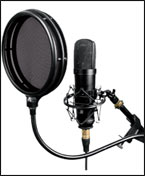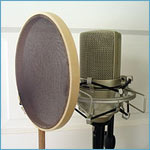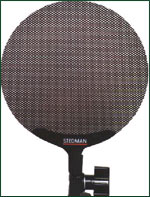Not a whole lot of guitar players cash in on the benefits of a pop filter, but no one can blame them. Most of the affordable pop filters break or fail within weeks of having them- or don’t even work at all. This has led a lot of innovative guitar players who are looking to record vocals to become creative- everything from putting a shirt over their mouth to making makeshift pop filters from tennis rackets.

Figure 1 – They may resemble tennis rackets, but pop filters can mean the difference between a professional sound, and just another home-made recording.
A pop filter serves as the sole purpose to clean up vocals. It will eliminate the “pop” sound that vocalists make while pronounced words that start with a ldquo;p” or “b”. Words that give this undesired popping sound are called aspirated plosives. Words that make a hissing sound, such as the word “seashell”, are called fricatives. Essentially, pop filters attenuate these undesired sounds before getting to the microphone. Small vocal blemishes must be removed to get a professional recording- but not everyone can afford to buy a professional pop filter.
Basically, a pop filter is just a piece of nylon stretched over a frame that goes between the vocalist and the microphone. The problem with most cheap pop filters is the simplicity- the attachment that aligns the pop filter with the microphone almost always breaks or becomes unreliable. Professional pop filters also seek to mask frequencies in which the microphone is not designed to pickup- which would otherwise lead to clipping.

Figure 2 – Here is another cheap home-made pop filter. They may not look the best, but they’ll often get the job done.
There are two solutions for avoiding the hassle of a cheap pop filter. The first is to fashion one by spare parts. Putting nylon over a tennis racket, for instance, is one of the more popular makeshift pop filters. Coat hangers work well, since they are bendable. Coat hangers also work well for attaching the pop filter to the microphone stand- although a little work might be required to get it perfect. While this is a cheap solution, it isn’t professional- but it depends on what the individual needs the pop filter for.
For professional pop filters, the price can go from $40 to $60. This may not seem like a lot, but keep in mind that a piece of nylon and a frame is being bought here. With this kind f price, the options are much more convenient than the average $15 pop filter. The gooseneck and clamp are one of the main problem areas that are fixed with professional pop filters. Some professional pop filters also accustom to special needs, such as double filters or a wider radius of coverage. The more expensive pop filters will even have metal filters- not nylon.

Figure 3 – This is a metal pop filter- it costs more money, but the results are much more favorable than that of nylon materials.
Not every cheap pop filter will fail- but on average, they don’t last as long as the more expensive ones. The most faulty part is the gooseneck and clamp, so be sure to either test one out at the local music store or get a good review of a pop filter before buying one. If all else fails, and a sense of professionalism isn’t needed, grab some spare parts from the garage or closet and see what you can come up with.

Some people still don’t get it about the pop filters and are reluctant to use them. This always changes as soon as someone tries to record something. My rule of mouth is putting your hand over your mouth, about one inch away and sing into it. You will feel the plosive sounds against your fingers. This is what hits the microphone and spoils the recording.
Thanx for this nice article.
I have seen some videos on it but they say that it doesn’t makes any difference using a mic with or without a pop filter.